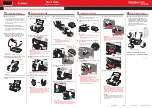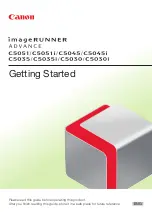
EFP9800 ESC/POS Commands
3255 4073– 002
6– 57
Real Time Commands
The following three situations must be understood when using real time
commands.
1. First, the printer performs the real time command upon receiving it and will
transmit status regardless of the condition of the DSR signal.
2. Second, the printer transmits status whenever it receives the real time
status transmission command sequence, even if that sequence happens to
occur within the data of another command, such as graphics data.
In this case, the sequence is handled correctly for its intended use.
3. Care must be taken not to send a real time command within the data
sequence of another command that consists of two or more bytes.
In this case the printer will use the real time command sequence bytes
instead of the other command’s bytes when finally performing that other
command from the buffer. The other command will not be performed
correctly.
These three situations generally preclude use of standard DOS drivers for the
serial communication ports when using real time commands.
If RS-232C communications, another consideration is that an application should
take care not to let the buffer fill up with real time commands when the printer
is busy at the RS-232C interface. A busy condition at the RS-232C interface can
be determined by bit 3 of the response to DLE EOT 1. The reason for a
particular busy condition can be determined by other responses to DLE EOT
n
.
Although the printer responds to real time commands when it is busy, it will
place them into the buffer behind any other data there, and flush them out in
the order in which they were received. When the printer is busy due simply to
buffer full (that is, it can’t print data as fast as it can receive it), then data
continues to be processed out of the buffer at approximately print speed and
the real time commands will eventually get flushed out.
When the printer is busy due to an error condition, then data stops being
processed out of the buffer until the condition clears one way or another. In
either case, but more quickly in the case of an error condition, the buffer can fill
with real time commands.
When the DLE sequences are being used, the last byte stored when the buffer
fills up could be the DLE code, with no room for the subsequent EOT or ENQ.
Содержание E-@CTION EFP9800
Страница 4: ...Page Status iv 3255 4073 002...
Страница 16: ...Contents xvi 3255 4073 002...
Страница 72: ...Diagnostics and Print Tests 3 34 3255 4073 002...
Страница 80: ...When Something Goes Wrong 4 8 3255 4073 002...
Страница 85: ...Communication 3255 4073 002 5 5 RS 232C 25 Pin Host Computer to 9 Pin Communication Connector Pin Assignments...
Страница 127: ...EFP9800 ESC POS Commands 3255 4073 002 6 37...
Страница 128: ...EFP9800 ESC POS Commands 6 38 3255 4073 002...
Страница 204: ...NCR 5021 Printer Emulation Commands 8 16 3255 4073 002...
Страница 219: ...EF4270 Emulation Commands 3255 4073 002 9 15...
Страница 240: ...Flash Download Commands 10 12 3255 4073 002...
Страница 254: ...MICR Commands and Parsing 11 14 3255 4073 002...
Страница 263: ...Specifications 3255 4073 002 A 9 Dimensions...
Страница 265: ...Specifications 3255 4073 002 A 11 Character Sets Code Page 437 PC US...
Страница 266: ...Specifications A 12 3255 4073 002 Code Page 850 PC Multilingual...
Страница 267: ...Specifications 3255 4073 002 A 13 Code Page 852 Eastern European CRT Character Set Code Page 852...
Страница 268: ...Specifications A 14 3255 4073 002 Code Page 865 Nordic Languages...
















































